Monsters from myths. Legend of Charybdis: In Greek mythology, a monster that lives in a narrow strait under a rock on which a fig tree (fig) grows. Nobody saw him. Charybdis hides under water, with its giant mouth wide open, and the waters of the strait with a roar pour inward into the black hole. Three times a day, the monster swallows water along with ships and sailors, and then spews it out, forming giant whirlpools. And on the opposite bank of the strait there is another rock, from which six terrible heads of Skilla (Scylla) (see) stretch into the sea on long necks, grabbing sailors from passing ships. Whoever escapes Skilla falls into the mouth of Charybdis, and even Poseidon is unable to save the unfortunate. Only the cunning Odysseus managed to escape the sad fate when he was wrecked and the current carried him into a terrible abyss. Jumping up, he grabbed the branches of a fig tree and hung over the abyss until the waters threw back the wreckage of his ship. The king of Ithaca perched on the mast, and he was carried out into the open sea.
Legend of Python: In Greek mythology, a monstrous dragon born of Gaia. Python guarded the sanctuary of the goddesses Gaia and Themis in Delphi, at the same time devastating their surroundings. Therefore, it was also called Dolphin. At the behest of the goddess Hera, he brought up even more scary monster- Typhon, and then began to pursue Leto, the mother of Apollo and Artemis. The grown-up Apollo, having received a bow and arrows forged by the god of blacksmiths and gunsmiths Hephaestus, went in search of a monster and overtook him in deep cave. Showered with a hail of arrows, Python fell lifeless, and on the site of the stadium, Apollo erected a temple where the prophecies of his father, the supreme god of the Olympians Zeus, were announced, and established the Pythian Games, which were second only to the Olympic Games in their scope. The Temple of Apollo at Delphi became famous throughout Hellas and even beyond its borders. flocked here statesmen, commanders, philosophers and many others who wanted to know their fate. They brought rich gifts, and countless treasures accumulated in the temple. From a crevice in the rock, located in the middle of the temple, vapors rose, which had a strong effect on the consciousness and behavior of a person. The priestesses of the temple, the Pythians, mounted a gold-covered tripod and prophesied. Their sayings were mysterious and given for the most part in symbolic form. One of greatest works ancient world- a sculptural image of Apollo defeating Python, known as Apollo Belvedere, is now stored in the Vatican Museum.
Legend of the Gorgons: In Greek mythology, monsters, daughters of the sea deities Phorky and Keto. Their three sisters (Stheno, Euryale and Medusa), the two older ones are immortal, only Medusa could be killed. They live far to the west, on an island in the Ocean, not far from the gardens of the Hesperides, and only their gray sisters (see) know the way there. All of them were once beauties, but with their exorbitant vanity they greatly annoyed the gods, and they turned them into winged monsters. The bodies of the Gorgons were covered with shiny scales, instead of hair on their heads, poisonous snakes hissed and wriggled, a huge tongue and sharp fangs protruded from their mouths, their eyes burned with furious malice. Their appearance was so terrible that at the mere sight of them, everyone immediately turned into stone. On wings with golden glittering feathers, the gorgons quickly rushed through the air and everyone they met was torn apart by their sharp claws. When Zeus' son Perseus went to retrieve Medusa's head, the gods came to his aid. Athena gave him a shiny copper shield, which reflected everything as in a mirror. Hermes handed over his sharp sword. Hades borrowed a helmet that made anyone who wore it invisible. The nymphs presented winged sandals and a magic bag. Approaching the island, Perseus looked at the reflection in the copper shield and saw terrible gorgons sleeping in the sun. The snakes on their heads sensed the enemy and with a menacing hiss rose to meet them, but, like lightning, a sharp sword flashed and cut off Medusa's head with one blow. Blood gushed over the rock, and with it, the giant Chrysaor appeared from the body of Medusa and soared into the sky. winged horse Pegasus. The immortal gorgons woke up and began to rush through the air with noise, trying to find the killer of their sister, and Perseus, having hidden his severed head in a wonderful bag, was already quickly rushing over the sea, invisible in a magic helmet. The head of Medusa did not lose its deadly power even after the death of the monster, and many more turned to stone at the sight of it.
Echidna Echidna (Έχιδνα), in Greek myth-making, a monster, half-maiden-half-snake, daughter of Phorkis and Keto, granddaughter of the land of Gaia and the sea of Pontus (Hesiod, Theogony, 295-299). According to the presentation of Apollodorus, Echidna was the offspring of Gaia and Tartarus, according to other legends - Chrysaor and Kalliroi. Her face was beautiful, but terrible in her snake essence. Echidna lived in a gloomy cave underground, going out hunting, lay in wait for travelers in Arcadia and devoured them. The children of Echidna from Typhon were: the two-headed dog Orf, the three-headed Cerberus, the Lernean Hydra, the Chimera, Scylla, the Sphinx, the Eagle that pecked at the liver of Prometheus. From Orff, Echidna gave birth to the Nemean lion (Hesiod, Theogony, 306-327). Echidna was killed during her undisturbed sleep by Argus Panopt. According to the Black Sea legends from Zeus and Hercules, Echidna gave birth to the ruler of Scythia, the king of Scythus, Agathris and Gelon. Echidna is by nature a chthonic deity, whose power, embodied in his descendants, was destroyed by the great heroes Hercules, Bellerophon, Oedipus, marking the victory of ancient Greek heroic mythology over primitive teratomorphism. History reference. In ancient times, the Greeks knew two Scythia (Σκυθια) - European and Asian. Although the first became known to the Greeks before the second, but in fact was its colony. Already in Homer's Iliad "mare milkers" are mentioned as inhabitants of Scythia. The name Scythia is found for the first time in Hesiod in the 8th century BC, then in Alcaeus, Simonides, Aeschylus, Hecateus, Hellanic. The true treasure of news about the Scythians is the IV book of the history of Herodotus, written in the second half of the 5th century BC. Many later Greek and Roman writers wrote about Scythia, such as Dion Chrysostom, Strabo, Ptolemy, Tacitus and others; but until now Herodotus remains the most valuable and richest source of information about Scythia. Before Herodotus, in the 7th century, a certain Aristaeus from Prokopnes visited Scythia; he was with a people neighboring with the Scythians, the Issedans, and even wrote a poem about the Arimasians, one-eyed people; but Aristaeus is a mysterious person, mystically inclined, and his poem, which has not come down to us, was rather a set wonderful stories about extraordinary peoples and fabulous lands, rather than the notes of an inquisitive and observant traveler. True, Herodotus himself has a disposition towards the miraculous and entertaining; he probably used the stories of Aristaeus, creating stories about the most remote and least known parts of the Scythian lands; but he dwelled with no less interest on many positive subjects concerning the geography, history and ethnography of Scythia. In all likelihood, Herodotus was in Scythia, at least in the areas closest to the Black Sea colonies, along the banks of the Dniester, Bug and Dnieper rivers. Important Information about the Scythian lands and the customs of the inhabitants, supplementing Herodotus, are found in the work of his famous contemporary Hippocrates "On Air, Waters and Localities". Herodotus was the first of his contemporaries (and more early historians and travelers) singled out Scythia as a special territory with certain boundaries and space from general concept lands to the north, northwest and northeast of the Black Sea
Legend of the Harpies: In Greek mythology, half-woman, half-bird, hideous looking. The gods send them to punish mortals. The word "harpy" comes from the Greek "grab", "abduct". AT ancient myths Harpies were gods of the wind. They interfered little in the affairs of people, their duty was only to carry the souls of the dead to underworld. But then the harpies began to kidnap children and annoy people, swooping in suddenly, like the wind, and just as suddenly disappearing. In various sources, harpies are described as winged deities with long flowing hair, flying faster than birds and winds, or like vultures with female faces and sharp, hooked claws. They are invulnerable and stinking. Eternally tormented by hunger, which they cannot satisfy, the harpies descend from the mountains and, with a shrill squeak, devour and soil everything. The myth of the Argonauts tells how two harpies tortured the Thracian king and soothsayer Phineus, dooming him to starvation. The Argonauts Zeta and Kalaid, the winged sons of the north wind of Boreas, drove out the harpies and thus saved the king of Thrace. The rainbow goddess Irida prevented them from killing the monsters. Myths placed harpies on islands in the Aegean, and later in realm of the dead along with other monsters. The five daughters of the sea deity Thaumant and the oceanid Electra, according to legend, were originally beautiful women. However, for their vile and quarrelsome nature, they were turned by the gods into ugly birds, to which women's faces and breasts were preserved as a memory of their human origin. Their names Aella (“wind”), Aellope (“whirlwind”), Podarga (“swift-footed”), Okipeta (“fast”), Kelaino (“gloomy”) symbolized darkness and wind, sounded like a hidden threat, inspiring horror. In Greek mythology - half-woman half-birds of a disgusting look. The gods send them to punish mortals. The word "harpy" comes from the Greek "grab", "abduct". In ancient myths, harpies were gods of the wind. They interfered little in the affairs of people, their duty was only to carry the souls of the dead to the underworld. But then the harpies began to kidnap children and annoy people, swooping in suddenly, like the wind, and just like that, suddenly disappearing. In various sources, harpies are described as winged deities with long flowing hair, flying faster than birds and winds, or as vultures with female faces and sharp hooked claws. They are invulnerable and stinking. Eternally tormented by hunger, which they cannot satisfy, the harpies descend from the mountains and, with a shrill squeak, devour and soil everything. The myth of the Argonauts tells how two harpies tortured the Thracian king and soothsayer Phineus, dooming him to starvation. The Argonauts Zeta and Kalaid, the winged sons of the north wind of Boreas, drove out the harpies and thus saved the king of Thrace. The rainbow goddess Irida prevented them from killing the monsters. Myths placed harpies on islands in the Aegean, and later in the realm of the dead, along with other monsters. It's hard to imagine more ferocious and ugly characters in ancient mythology. They were not without reason ranked among the most dangerous monsters of the underworld of Hades, equating them with vultures. The only way to get rid of the vile creatures was the sound of brass instruments, only he could scare and drive away the harpies. However, not only in Greek mythology are there references to harpies. In the Middle Ages, harpies became a symbol of everything negative: greed, meanness, greed, revenge. So in the 13th song of Dante, fat harpy birds are mentioned. Monsters with strong beaks cut off flowers and leaves from talking plants, punch holes in them (thus causing unbearable pain to the sufferers), and from there sound the groans of the languishing souls of suicides executed in the seventh circle of hell. In our time, the "harpy" is a common noun, it is often awarded to wayward, unsympathetic people or characters from fairy tales and fantasy. For example, in the movie Van Halsing, Count Dracula's wives were three harpies, and in the Harry Potter book, the harpy was the mascot of the all-female Quidditch team, the Holyhead Harpies. In the era scientific and technological progress people interested in mythology use the internet to find information. Entering in any search engine the word "harpy", the first thing that will appear on the screen is "harpy photos" or "harpy pictures". But this is not all mention of harpies, there is a real harpy bird in the world (the winged wolf of American forests). A mighty forest eagle with extremely strong paws and huge claws, he is beautiful and terrible at the same time and, like his mythical namesakes, is distinguished by extraordinary gluttony.
By the number of "water women" in the first place, you can safely put Ancient Greece. Plato once joked that the Greeks are very much like frogs sitting around a pond, since the vast majority of their cities are located on the Mediterranean coast. It is not surprising that the mythology of this people is closely connected with water. Sirens were considered the most harmful and unusual of the "water maidens". Sirens are mythical female creatures, bird women or mermaids, who lure sailors and destroy them with their singing and enchanting music. Sirens live on one of the uncomfortable lifeless islands of Anfemoesse near Sicily. They were the offspring of one of the sea gods - either Phorkis, or Achelous (which is more likely) - and one of the muses, who probably hid her motherhood due to the nature of her daughters. At first they were all beautiful women. According to one of the legends, the sirens were turned into birds by Aphrodite, enraged by their pride and arrogance. According to another myth, the Muses awarded them with a bird's body because, proud of their beautiful voices, the sirens challenged the Muses to a singing competition. According to another version, the sirens were originally nymphs surrounded by the young goddess Persephone. When their mistress was kidnapped for his wife by the ruler afterlife Hades, her angry mother, the fertility goddess Demeter, gave the beautiful maidens a birdlike appearance. Finally, in another version, they themselves wanted to turn into birds in order to find Persephone, and when people did not help them, they moved in despair to a deserted island and began to take revenge on the entire human race. With the sweet singing of sirens, sailors were lured to the coastal cliffs and killed on the shore. Their voice was so beautiful that not a single person could resist; all the rocks of the island were strewn with the bones of their victims. In ancient times, sirens were perceived in the same way as the muses of another world. They were often carved on stone tombstones in the form of death angels singing funeral songs to the sound of a lyre. In the Middle Ages, sirens were very popular as symbols; they were widely used in the coats of arms of noble families. They were depicted not only with bird features, but also with a fish tail and even with the body of a four-legged animal. Sirens came to us from ancient Greek mythology, mainly from the legends of Jason and Odysseus (Ulysses, in Latin). Jason and the Argonauts in Argonautica, written by Apollonius of Rhodes (3rd century BC), meet the sirens, the daughters of the Akeloia River and the muse Terpsichore, half birds, half mermaids in appearance. Their singing attracted the Argonauts, and they would have died if Orpheus himself had not enchanted the Sirens with his playing the lyre. Homeric Odysseus tied his companions to the mast and plugged their ears so that they could not hear the sirens. Homer does not attribute any superhuman properties to them; judging by his poem, there were two sirens. Although Apollonius wrote later than Homer, the myth of Jason ancient history about the Odyssey. Sirens are traditionally depicted more as birds with female heads than female sorceresses, as some authors have tried to do, referring to Homer, who omitted their description in the Odyssey. Classical writers dealing with this topic have always depicted sirens in the form of birds. In the "Library" of Apollodorus (I - II century AD), the sirens are presented in the form of birds from the waist down, their names are Pisinoe, Aglaope and Telxiepia, they are the daughters of Akelous and the muse Melpomene, one plays the harp, the other plays the flute , the third sings. English historian James George Fraser (1854-1941) summarized references to sirens in the works classical writers. According to him, bird-like sirens are found in Elian ("De natura animalium"), Ovid ("Metamorphoses"), Higinus ("Fabula"), Eustathius ("On Homer's "Odyssey") and Pausanias ("Description of Hellas") . There are either two, or three, or four sirens in different versions. Their father is Akeloi or Forkes, the god of the sea, their mother is Melpomene, Terpsichore or Steropa. Siren names: Teles, Raidne, Molpe and Telksiope, Leukozia and Lygia or Telksione, Molpe and Aglaofonus or Aglaofem and Telksiepia. Apollodorus and Hyginus. believe that the sirens died after meeting with Odysseus, and thus ancient prediction an oracle that they would die when the ship passed them unscathed. Other authors claim that they drowned themselves out of vexation. Another version of the myth is known from a brief mention of the sirens in the "Description of Hellas" by Pausanias (2nd century AD): in Koronei there was a statue of Hera with sirens in her hand, "since the story says that Hera convinced the daughters of Akeloy to compete with the muses in singing. The Muses won, pulled the feathers from the sirens ... and made themselves crowns from them. " The English poet of the 16th century E. Spencer interpreted the meaning of this myth in the sense that mermaids symbolize temptation: "sorceress girls" were endowed with fish tails as punishment for their "arrogance" in competition with the muses. Paintings and sculptures of the preclassical and classical era sirens are also depicted with the bodies of birds, and it is rather difficult to distinguish them from harpies. Sirens were often depicted on ancient classical tombstones and could symbolize the souls of the dead or the spirits that accompany the soul to the god of the underworld, Hades (Hades). Dennis Page, in The Tradition of Homer's Odyssey, suggests that Homer may have come up with a description of his human-like sirens by summarizing the legends of escorting souls to the domain of Hades with legends of female demonic beings who, using their beauty, seduce and then kill American researcher John Pollard points out that works of art that have come down to us indicate that a number of associations and symbols are associated with sirens, preserved in literature, not counting the images of sirens on tombstones and those that met Odysseus and his companions. next to Theseus, Artemis, Hera, Athena, Dionysus; although most sirens are female, some, especially early eras have beards. They not only portend death or lead to death, but also deliver unearthly pleasure with their singing and symbolize animal strength. It is not known exactly when and in connection with what the sirens became associated with mermaids, losing their wings and leaving their nests on rocky islands to dive into sea waves. Perhaps this happened in the Middle Ages in connection with the spread of bestiaries. In Romance and some other languages, the word "siren" and its related forms began to be called mermaids, although the use of this word also indicates the influence classic look sirens. In the Italian legend "The Siren's Wife", the sirens who save and take care of the drowning wife are sung by sailors (this feature is also inherent in some mermaids, and not only in classical sirens); modern Italian writer Italo Calvino, in retelling the story, heightened the effect by composing the words to their song, which seemed to encourage sailors to jump overboard into the sea; siren with a fish tail in Ligeia by Giuseppe Tomasi di Lampedusa (in English translation"The Professor and the Mermaid") has classical name; the "little siren" Eleanor from Jean de Brunhoff's "Zephyr's Vacation" also has a fish tail, she is good-natured and by no means a seductress and she has no penchant for playing music. In the sixth century in North Wales a siren was caught and christened, and in some old calendars she is listed as a saint under the name Merjen. Another siren in 1403 slipped through a gap in the dam and lived in Haarlem until her death. No one could understand her speeches, but she learned to weave and, as if instinctively, worshiped the cross. A chronicler of the sixteenth century claims that she was not a fish, because she knew how to weave, and was not a woman, because she could live in water. AT English language different classic siren and mermaid with fish tail. The creation of the image of a mermaid may have been influenced by tritons, minor deities in the retinue of Poseidon. In the tenth book of the "Republic" of Plato, eight sirens control the movement of eight concentric celestial spheres. Do sirens really exist? It is unlikely that anyone will be able to give an exhaustive answer to this question. In the myths of the peoples of the world, sirens have a different appearance. Sometimes the siren was called the "soft water snake", the fairy Melusina or the lake siren. Sirens in the Renaissance were also called coquettish naiads - nymphs of rivers, streams and lakes. The image of these sirens began to appear in ballet performances, and the artists preferred to “undress” them. Apparently, they were really beautiful after all. And maybe there is?
Centaurs Centaurs in Greek mythology are wild mortal creatures with the head and body of a man on the body of a horse, inhabitants of mountains and forest thickets, accompany Dionysus and are distinguished violent temper and intemperance. Presumably, centaurs were originally the embodiment of mountain rivers and turbulent streams. AT heroic myths some centaurs are educators of heroes, others are hostile to them. AT ancient Greek myths tells about the wise centaur Chiron, a friend of King Peleus, tutor of his son Achilles. Chiron fed Achilles the brains of bears and the liver of lions so that he would grow up to be a mighty hero. The centaur also taught him to play the kefar and sing. The education of Achilles by the centaur Chiron. Hood. P.-J. Batoni
Python Python is scary dragon who lived in the gorge. At the behest of the goddess Hera, he pursued Latona, the mother of Apollo. When Apollo grew up, he first decided to find the gorge in which Python was hiding in order to avenge the persecution of his mother, for all the evil that he had done to her. Apollo flew over the island of Delos and noticed a gorge along the bottom of which a foamy stream rushed. This giant Python crawled out of his lair and drove the water. All living things hid from him: the birds flew away, the fish swam away, the animals scattered. Seeing the young god, Python wanted to swallow him, but Apollo turned out to be more agile. He fired his golden arrows into the open mouth of the dragon. They struck the dragon, and he fell lifeless to the ground.

Typhon Typhon is a powerful monster, born of Gaia, the personification of the fiery forces of the earth with their destructive actions. According to one version of the myth, Typhon was born by Gaia and Tartarus, according to another, the goddess Hera gave birth to him, hitting the ground with her hand. She did this in retaliation to Zeus, who himself gave birth to Athena. Typhon was brought up by Python - a huge dragon born of the goddess of the earth Gaia. Typhon is represented in legends as a creature with a hundred dragon heads, a body similar to a human, covered with plumage, instead of legs the monster had snake rings. Some sources report that Typhon's heads are human-like, but he can reproduce the cries of animals.


Minotaur The Minotaur is a terrible monster with the head of a bull and the body of a man. He lived on the island of Crete in the palace of the Athenian king Minos, called the Labyrinth, from which no one could find a way out. Every nine years the Athenians had to sacrifice seven boys and seven girls. And so it continued until the son of Theseus was born and raised by the Athenian king Aegeus. Having learned this story, he decided to go with the young people to the island of Crete in order to get into the Labyrinth Palace and kill the bloodthirsty monster there, to free the Athenians from the terrible tribute. Thanks to the help of Ariadne, the daughter of Minos, Theseus killed the Minotaur, found the boys and girls, and led everyone out of the Labyrinth.
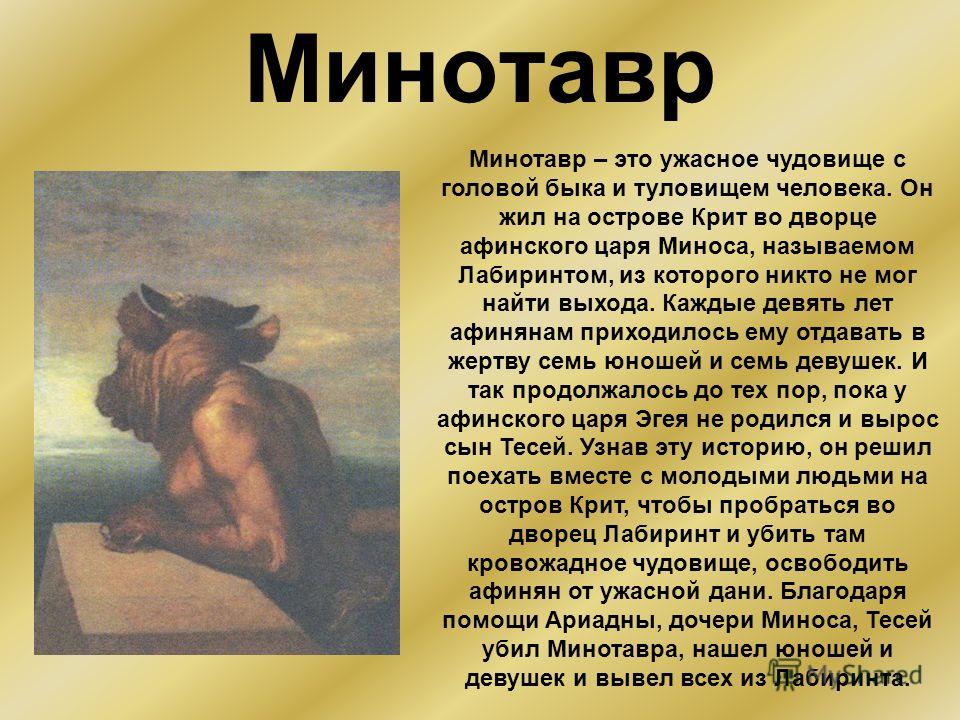
Gorgon Medusa Gorgons are winged sea creatures covered in scales and snakes for hair. Instead of hands, they had copper tentacles with steel claws. Their bloodshot eyes were filled with such terrible force that anyone who looked into them turned to stone. If they attacked a person, they tore him to pieces and drank blood. Chief among them was the Gorgon Medusa. She was defeated by the hero Perseus, cut off her head and brought it to King Polydectes as proof. Head of the Gorgon Medusa. Hood. Caravaggio Gorgon Medusa. Sculpture on the temple of Artemis Perseus with the head of the Gorgon Medusa. Antonio Canova
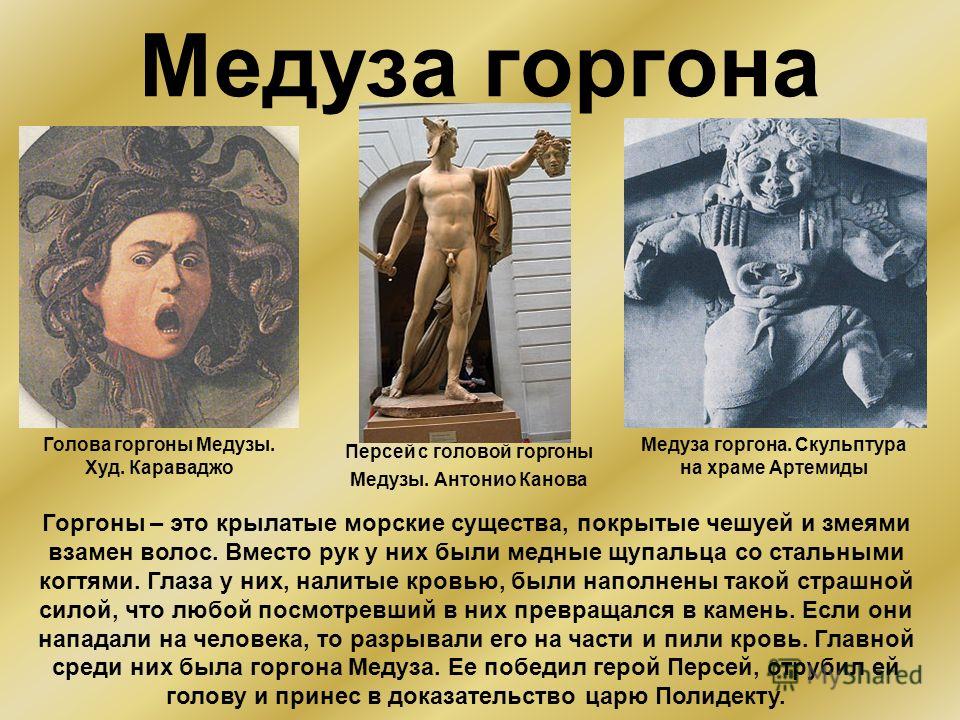
Pegasus Pegasus is a winged horse that was born from the head of the Gorgon Medusa cut off by Perseus. Since the horse was born at the source of the Ocean, it was named Pegasus (Greek, "stormy current"). Flying with the speed of the wind. According to legend, he had a stall in Corinth, lived in the mountains. Pegasus could knock out springs with a hoof strike on the ground. So, in particular, on Mount Helikon near the grove of Muses, the source of Hippocrene (Key of the Horse) arose, from which poets drew inspiration. Subsequently, Pegasus delivered thunder and lightning to Zeus on Olympus from Hephaestus, who made them. Placed in the sky in the form of the constellation Horse, now this constellation is called Pegasus.
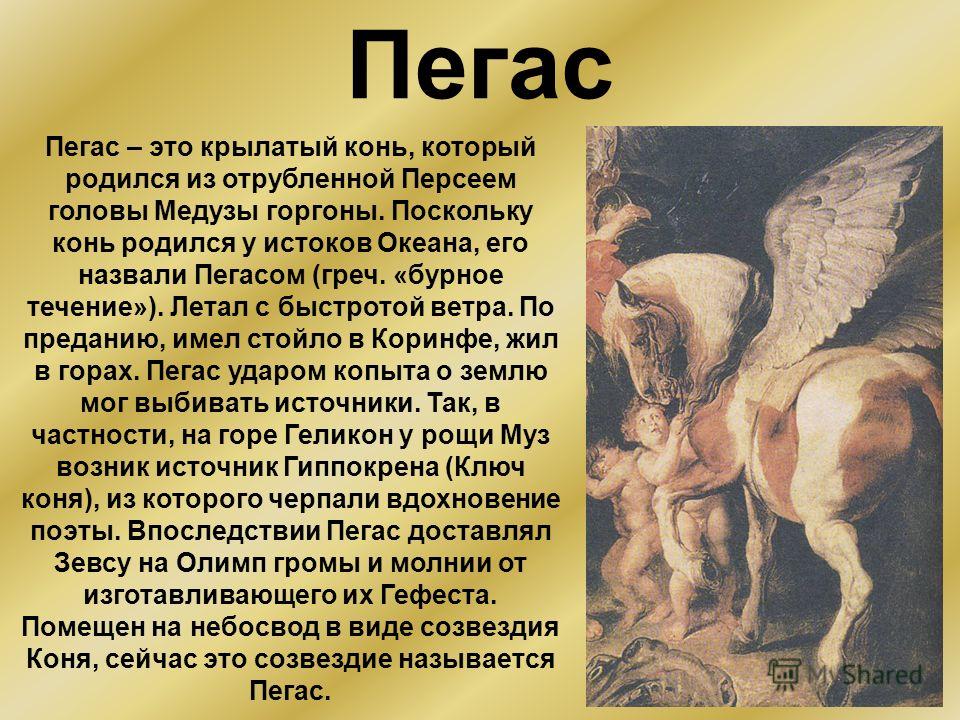

Trojan horse Transportation of the Trojan horse to Troy. Hood. J.-B. Tiepolo Trojan horse is a huge wooden horse that could fit the strongest and most courageous warriors. It was invented by the cunning Odysseus. For ten years the Greeks waged war against the Trojans and could not conquer the besieged city. The horse had to be left in front of the gates of Troy, and the whole army should sail away on ships away from the coast, so that the Trojans would think that the siege had been lifted and the Greeks were gone forever, and this wooden horse was like a gift from them. The Trojans, having opened the gate, were surprised by the giant horse, and after much deliberation, they wheeled it into the city and closed the gate. And at night, the Greeks got out of the inside of the horse, opened the gates and let in the Greek army that arrived in time. The Greeks burned Troy to the ground.

Cyclops Polyphemus Cyclopes are ferocious humanoid giants. These creatures did not observe any laws, did not engage in agriculture, grazed only cattle. The land on which they lived gave them various fruits in abundance. The Cyclopes lived in solitude, hiding in huge caves and did not visit each other. Cyclops Polyphemus, the most ferocious and unsociable, has great strength, has only one eye in his forehead. Only Odysseus managed to defeat this one-eyed cyclops by cunning. Cyclops Polyphemus. 3rd century BC.

The Sphinx The Sphinx is a monster with the head of a woman, the body of a lion, and giant wings. With just his appearance, he frightened people. He settled near the city of Thebes on Mount Sphingion and demanded human sacrifices for himself. The gods sent him to Thebes, they also decided that he would disappear when someone could solve his riddle, which he asked everyone who passed by. The riddle was solved by Oedipus, who later became king in Thebes. One of the largest monolithic statues in the world is the statue of the Sphinx, which guards the pyramids of the pharaohs in Giza. Presumably the image of the Egyptian sphinx was borrowed by the ancient Greeks. Sphinx. Figured vessel Greek sphinx (sphinga) egyptian sphinx in Giza
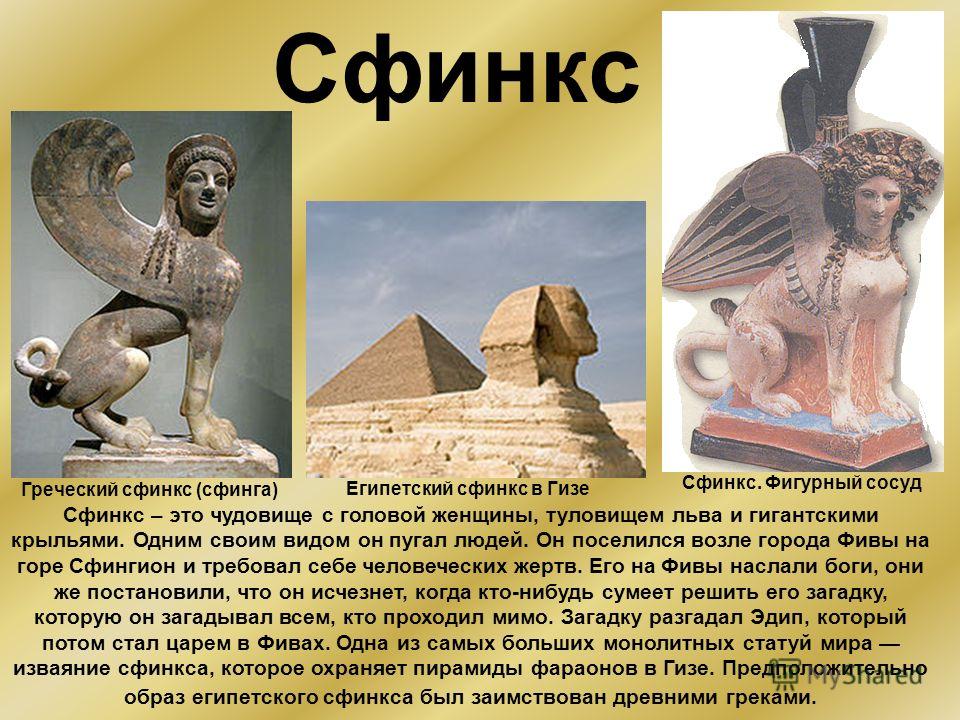

Satyrs Satyrs in Greek mythology are forest deities, fertility demons, cheerful goat-footed creatures that inhabited the Greek islands. Hesiod tells about their origin. They made wine for the first time. They were famous for their addiction to alcohol. Satyrs made up the retinue of Dionysus, always having fun and singing. Nymphs and Satyr
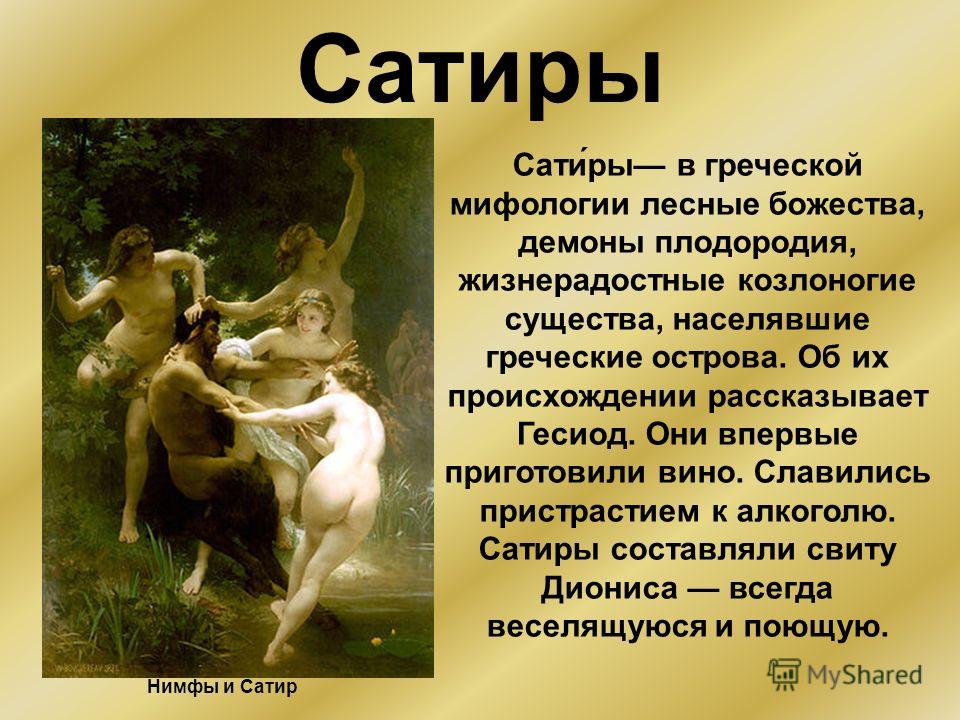
Sirens Sirens in Greek mythology are sea creatures who personified a deceptive but charming sea surface, under which sharp cliffs or shoals are hidden. These are half-birds, half-women, who inherited from their father, the sea god Forkis, a wild spontaneity, and from their mother, the muse, a divine voice. With enchanting songs, sirens lured travelers passing by, who, forgetting everything in the world, swam to the magical island and perished along with the ships. Only Odysseus escaped the insidious sirens only thanks to the warning of Circe: he covered the ears of his companions with wax, and ordered himself to be tied to the mast. John William Waterhouse, Odysseus and the Sirens

Harpies Harpies - in Greek mythology, the daughter of the sea deity Thaumant and the oceanid Electra, the number of which ranges from two to five. Usually they are depicted as disgusting half-birds, half-women. The myths speak of harpies as vicious kidnappers and human souls. From the harpy Podarga and the god of the western wind Zephyr, the divine fleet-footed horses of Achilles were born. According to legend, harpies once lived in the caves of Crete, and later in the realm of the dead.

Gargoyles Gargoyles Tribe of demons Bruce Pennington Gargoyle Winged monster Gerald Brom Gargoyle - in Greek mythology, the embodiment of a generalized idea of an indefinite formless divine power, evil or beneficent, which determines the fate of a person. Performing suddenly, without any reason, a certain action, it disappears without a trace. Gargoyles are also called lower demonic winged deities, mediators between God and people.

Griffin Griffins fictional winged creatures, half lions, half eagles. They have sharp claws and snow-white or golden wings. These mystical creatures symbolize power over heaven and earth, strength, vigilance and pride. The griffin also became an attribute of the goddess of retribution Nemesis: he turned her wheel of fortune. For the first time they are mentioned by the poet of the VI century. BC e. Aristaeus of Proconnes, as well as Aeschylus (Prometheus 803) and Herodotus (History IV 13).

unicorn unicorn mythical creature symbolizes chastity. It is usually presented in the form white horse with one horn coming out of the forehead. In early traditions, the unicorn was also depicted with the body of a bull, goat and horse. In Greek mythology, the unicorn was dedicated to the goddess Artemis.
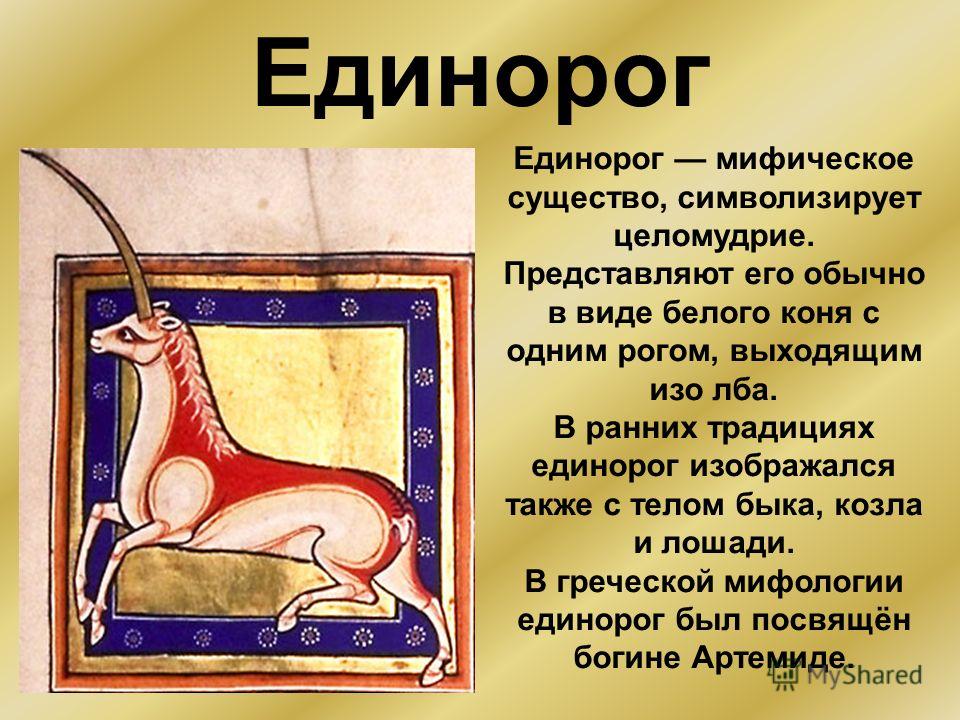
Lamia Lamia is a character of ancient Greek mythology, the daughter of Poseidon, a monster. Once Lamia was the queen of Libya, the beloved of Zeus and gave birth to children from him. Hera, out of jealousy, killed them and deprived the beloved of the supreme god Zeus of sleep. Lamia was forced to take refuge in a cave and, at the behest of Hera, turned into a bloody monster that abducted and devoured other people's children. Since Hera deprived her of sleep, Lamia wandered tirelessly at night. Zeus, who took pity on her, gave her the opportunity to take out her eyes in order to fall asleep, and only then could she become harmless.

Lernaean Hydra In ancient Greek mythology, the Lernaean Hydra is a snake-like monster with poisonous breath that lived in groundwater, slain by Hercules as one of his twelve labors. Hera nursed her. For the first time, the poet Pisander ascribed many to her instead of one head. According to one of the descriptions, a snake with nine heads, either it had 50 heads, or a hundred necks grew out of the body, instead of one cut off, three grew, and one head was immortal. The lair of the hydra was Lake Lerna near Argolis. Under water was the entrance to the underworld of the dead, which was guarded by a hydra. Antonio del Pollaiolo. Battle of Heracles with the Lernean Hydra

Nemean lion The Nemean lion in ancient Greek mythology is a lion of monstrous size with an incredibly hard skin, which is why it was not taken by any weapon. The beast lived in the mountains near the city of Nemea (a city in the northeast of the Peloponnese) and devastated all the surroundings. The first task of Hercules for the Mycenaean king Eurystheus was to kill the Nemean lion. The abode of the monster was a cave with two exits. To catch the beast, Hercules blocked one of the exits with stones, and when the lion emerged from the cave during twilight, the hero fought him. Since the weapon could not penetrate the skin of the Nemean lion, they had to grab it by the throat, strangle the monster and bring the skin of the lion as proof of the accomplished feat and their own superhuman strength. Battle of Heracles with the Nemean Lion
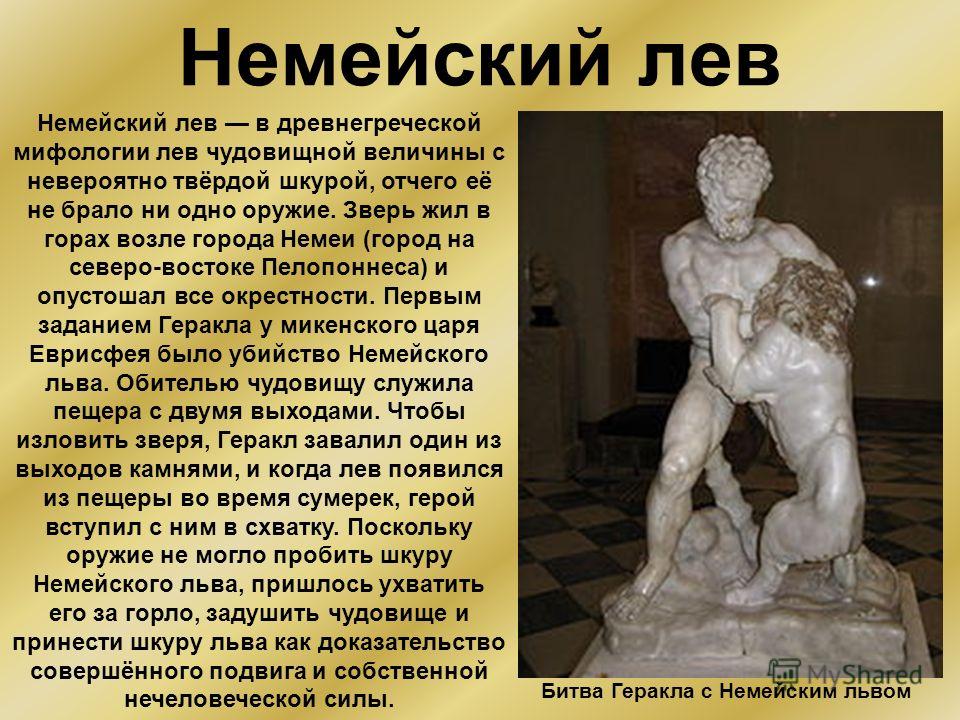
Stymphalian birds Stymphalian birds in ancient Greek mythology are birds of prey that lived near the Arcadian city of Stymphalus. They were fed by Ares and had copper beaks, wings and claws, attacked both people and animals. Their most formidable weapons were feathers, which the birds poured onto the ground like arrows. They devoured crops in the area, or ate people. The Mycenaean king Eurystheus ordered Hercules to defeat the Stymphalian birds. Pallas Athena helped the hero to complete this difficult task: she gave Hercules two copper tympanums forged by Hephaestus. The goddess ordered to set tympanums on the mountain near the nesting place of terrible birds and hit them. The deafening sound of the tympans was supposed to make the birds rise into the air, and Hercules should shoot them with a bow. Hercules scared the birds and shot them. Hercules and the Stymphalian Birds. Fragment of a Roman mosaic
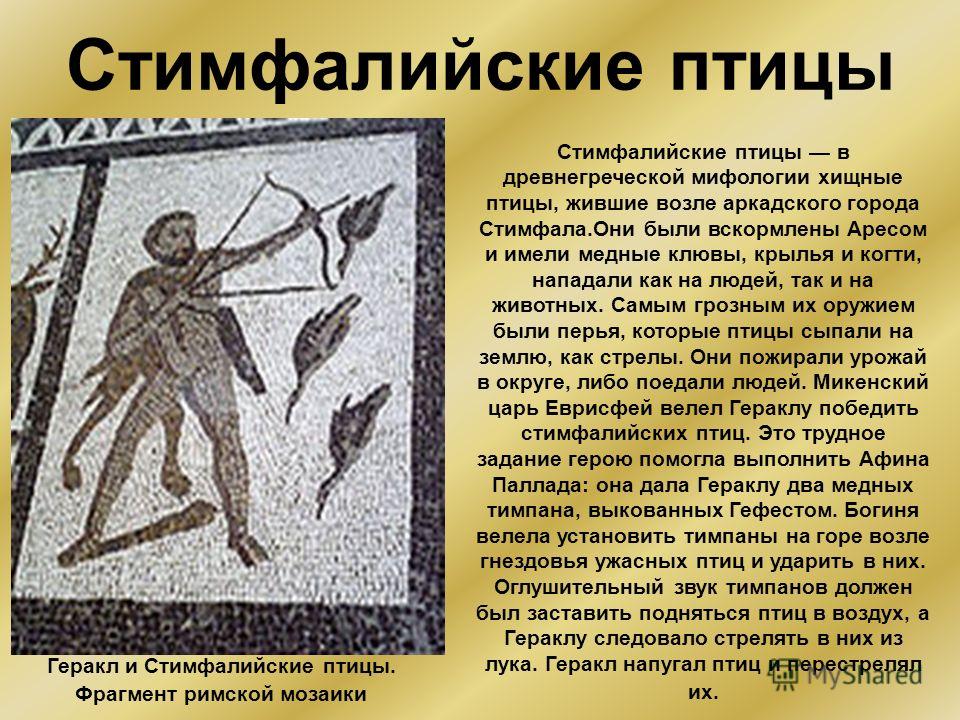
Phoenix Phoenix is a mythological bird that has the ability to burn itself. It was believed that the phoenix has appearance an eagle with bright red plumage. When a phoenix senses the approach of death, it builds a nest, which it then exposes to the scorching rays of the sun until it burns to ashes in their flames. Then a new phoenix arises.
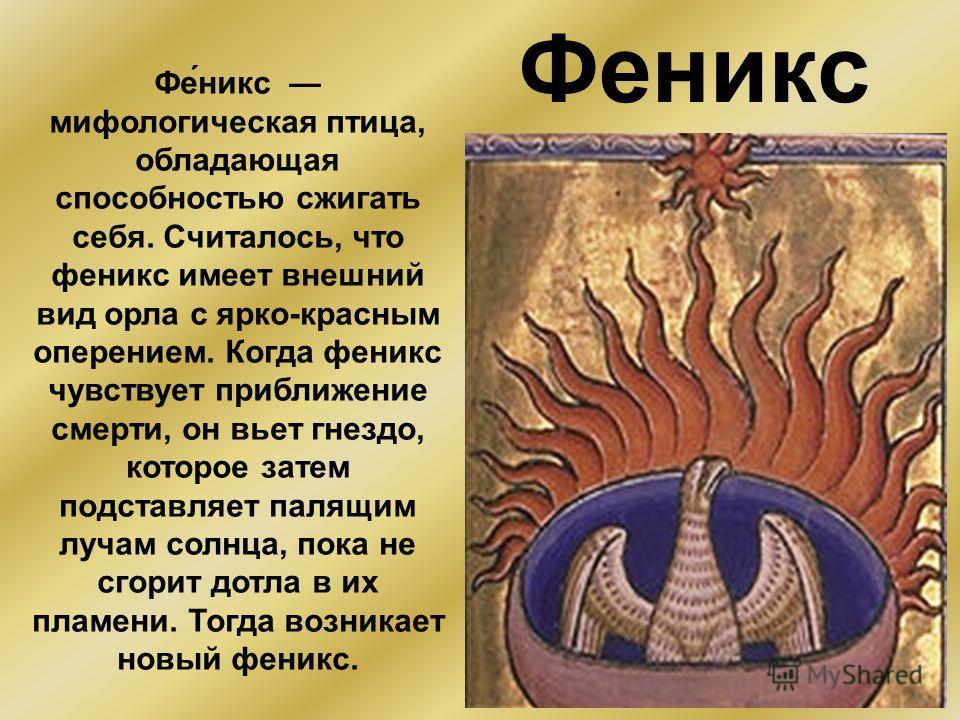
Chimera Chimera - a character of ancient Greek mythology, a three-headed monster: one head was a lion, the second - a goat, grew on its back, and the third - a snake - the creature's tail ended. The front part of the body of the Chimera was lion, and the back was goat. From the mouth of the monster, fire escaped, with which it destroyed the houses and crops of the inhabitants of Lycia. It was believed that the Chimera lived in hard-to-reach mountains. Not a single person dared to come close to her dwelling. The king of Lycia sent his troops several times to destroy the Chimera, but not a single warrior returned alive from the campaign. The son of the king of Corinth, Bellerophon, riding the beautiful Pegasus, flew up to the monster's lair and saw a horse-sized creature on the ground that spewed flames and roared menacingly so that the air shook around. Having removed the bow from his shoulder, Bellerophon fired all the arrows at the Chimera and was able to destroy the formidable enemy. After that, he went down to the valley, cut off the heads of the Chimera and delivered one of them to the king of Lycia.
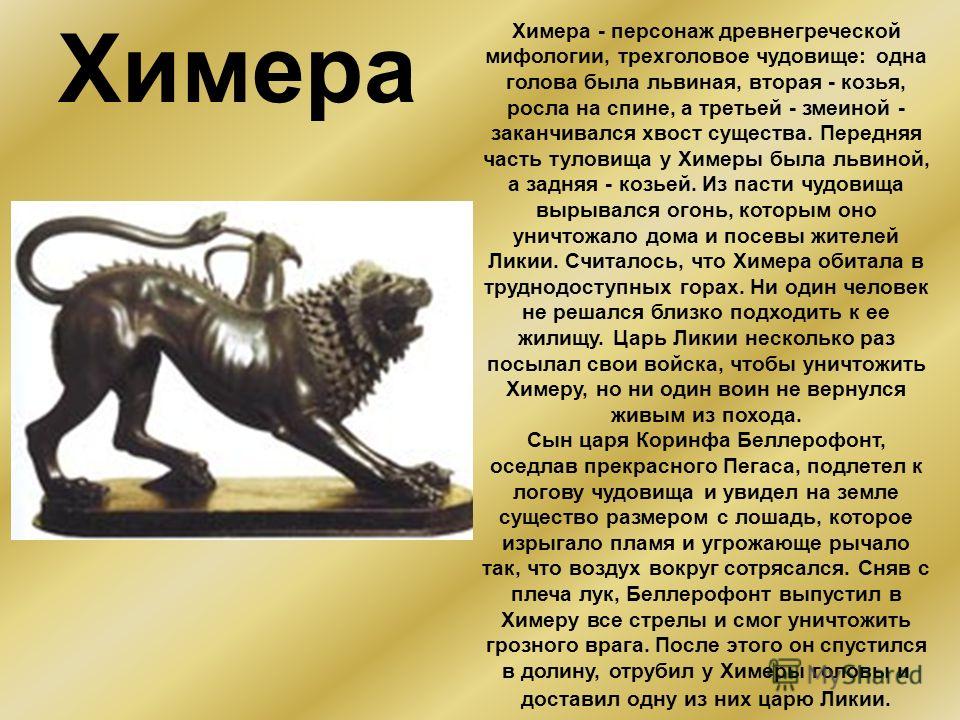
![]()
Sources 1.Legends and legends Ancient Greece and ancient rome. M., Pravda, Kubeev M.N. 100 great legends and myths of the world. M., "Veche", Kubeev M.N. 100 great wonders of the world. M., "Veche",


All horror ancient man before the mighty forces of nature embodied in mythological images gigantic or vile monsters. Serpents, dragons and demons were a form deeply alien to all human: scales, claws, wings, a hefty mouth, horrible power, unprecedented properties, huge size. Created by the rich imagination of the ancients, they combined body parts of familiar animals, such as the head of a lion or the tail of a snake. The body, composed of heterogeneous parts, only emphasized the enormity of these disgusting creatures. Many of them were considered the inhabitants of the deep sea, personifying the hostile power of the water element. The myths that have survived to this day are full of dramatic stories about gods and heroes who fought dragons, giant snakes and evil demons and won in a seemingly unequal battle.
Dragons are winged snakes, in the form of which animals were combined, embodying two worlds - the upper (birds) and the lower (snakes). These fantasy creatures, which, for example, Chinese mythology personified the masculine principle, the primary element yang, along with the phoenix, embodying the feminine principle, the primary element yin, were often used in decorative arts. The image of the dragon served as a symbol of the emperor, and the phoenix - the empress. The combination of these graceful and whimsical creatures in the view of the Chinese symbolized the harmony of family happiness.
AT ancient mythology monsters are represented by a rare wealth of shapes, colors and sizes, more often they are ugly, often magically beautiful; often they are half-humans, half-beasts, and sometimes they are absolutely fantastic creatures. The monsters symbolized the dark, uncontrollable forces of nature. Greek mythology replete with various kinds of monsters, such as the Chimera, Sphinx and Skilla, which is associated with the complex nature of evil. Usually the monsters turned out to be vicious and cruel creatures, however, some of them perform protective functions, such as, for example, Ladon, a dragon guarding golden apples in the garden of the Hesperides; others, like the Chimera, devastated entire lands; others were created by the gods as a punishment to people, like a sea serpent that strangled Laocoön and his sons. These creatures, as well as satyrs and centaurs, half-humans, half-animals, were a bizarre embodiment of a painful fear of losing their human appearance or horror at the deeds that human fantasy attributed to monsters.
Typhon, a terrible snake-like monster whose eyes emitted flames, was conceived by mother earth Gaia from Tartarus. This bearded and hairy creature, which had a hundred dragon heads, emitted wild voices of bulls, lions and dogs with each of its mouths. The ancient Greeks believed that Typhon intended to become the supreme deity, but the Thunderer Zeus struck him with thunderbolts. The constant activity of Mount Etna in Sicily was explained by the breathing of a prisoner under the Typhon crater. According to one version of the myth, the victory was given to Zeus with great difficulty: Typhon embraced him with his scaly rings, cut his tendons and imprisoned him in the Korikian cave in Cilicia, where Zeus was guarded by the dragon Delphine. Fortunately, the messenger of the gods Hermes came to his aid. Shortly before his defeat, Typhon fathered the fire-breathing Chimera, a huge sea monster, later killed by the glorious hero Perseus. Demons, lower deities or spirits, sent misfortunes and directed people on the wrong path.
AT Slavic mythology there are many myths about animals and birds, as well as creatures endowed with a bizarre appearance (half-birds, half-women, human-horses) and extraordinary properties. First of all, it is a werewolf, a wolf-dlak. The Slavs believed that sorcerers could turn any person into a beast with a spell. This is the frisky half-man-half-horse Polkan, reminiscent of a centaur; miraculous half-birds-half-maidens Sirin and Alkonost. An interesting belief among the southern Slavs is that at the dawn of time all animals were people, but those of them who committed a crime were turned into animals. Instead of the gift of speech, they received the gift of foresight and understanding of what a person feels. It was believed, for example, that the mournful crowing of a cuckoo foreshadowed trouble or promised a certain amount of lived years.
A vulture bird, a mythical creature, half bird, half beast, its feathers are pointed like arrows, its claws and beak are iron. It was believed that the vulture bird nested in twelve oaks. In folk memory, this bizarre creature was imprinted in various guises: a gigantic bird, like black clouds, covering the sky, darkening sunlight; from the flapping of her gigantic wings a storm rose, the blue-sea waved. In those distant times, people believed that “the vulture lives in Asian Scythia (i.e., in Siberia), owns gold, silver, and violently attacks those who encroach on its wealth, punishes the greedy.” Griffin came to Slavic lands from the East, where, like the lion, it was considered the emblem of royal power, through Italy and Byzantium; perhaps there was also the influence of the Greek griffin, the “dog of Zeus”, guarding gold in the country of the Hyperboreans, whom Apollo loved.
Gamayun - in East Slavic mythology, a prophetic bird with woman's face and breast, the messenger of the gods, their herald, singing divine hymns and predicting the future for those who know how to hear the secret. Gamayun knows about the origin of the earth and sky, gods and heroes, people and monsters, birds and animals. It was believed that her cry prophesies happiness.
O About four thousand years separate us from the beginning of the civilization of Ancient Greece. The people that he created immortal myths about the exploits of heroes - demi-gods - demi-humans. The Greeks endowed their heroes with the strength and courage of the gods. Perseus, protected people, destroying terrible mythical monsters.
Mythical monsters of ancient Greece
Siren
Siren - half woman - half bird, who, with her charming singing, lured sailors to her island, where they died, breaking on underwater rocks and reefs. In her hands, the siren held a flute, from which she poured magical music mesmerizing sailors. During his journey, the hero saved his friends from the destructive singing of the sirens by filling their ears with soft wax, and asked himself to be tied to the mast.
The ship of Odysseus very quickly sailed past the island of the Sirens, from which they heard magic singing. In their songs they promised all the pleasures of the world. From a distance, the sirens looked like beautiful girls, however, their body was bird-like.
Harpies

Harpies are winged mythical monsters who were considered goddesses of the storm. They, like the sirens, were half-woman - half-bird. Their heads were female, and their bodies were birdlike, on the arms and legs of the harpy they had long iron claws.
Echidna
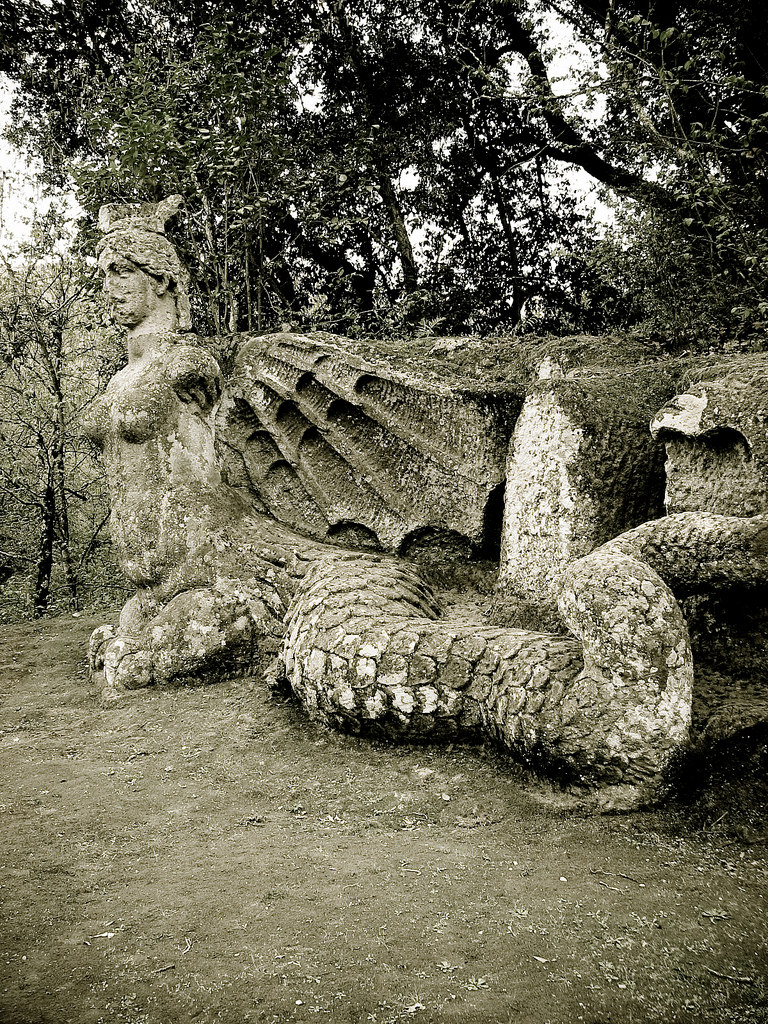
Echidna is a half-woman half-snake. She is the wife of the hundred-headed monster Typhon. The children born from this union are the three-headed dog Cerberus, the Lernean hydra, the Nemean lion and other monsters that Hercules destroyed.
Echidna had a long snake tail, with which she moved. To the waist, this monster had female body, and her head was decorated not with hair, but with poisonous snakes.
Her skin was so strong that even the sharpest sword could not pierce it. Although no one tried to get close to her, because she was huge as a mountain and just as strong.
Gorgons

These winged monsters turned to stone anyone who even looked at them. They were the daughters of the sea god Phorky. The beautiful daughters became ugly monsters as punishment for provoking the wrath of the goddess Athena.
Gorgons had animal ears, a long tongue, and red eyes. They lived in the west, where the goddess of the night and the god of death Tanat dominated. Of the three Gorgon sisters, it was considered the most dangerous, which, according to legend, was killed by Perseus. The closest relatives of the Gorgons were the Gasperides.
Python
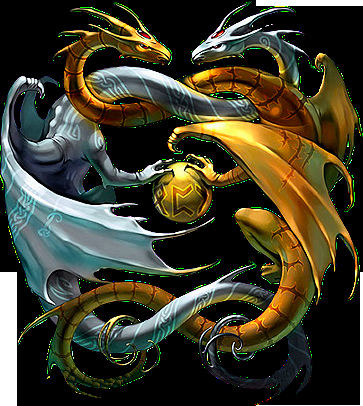
This dragon lived in a dark gorge. His body was completely covered with scales, and he was so huge that even the mountains trembled under his weight. The evil Python destroyed everything around until the god Apollo dealt with him, burying him in the ground near the mountains of Delphi.
Hesperides
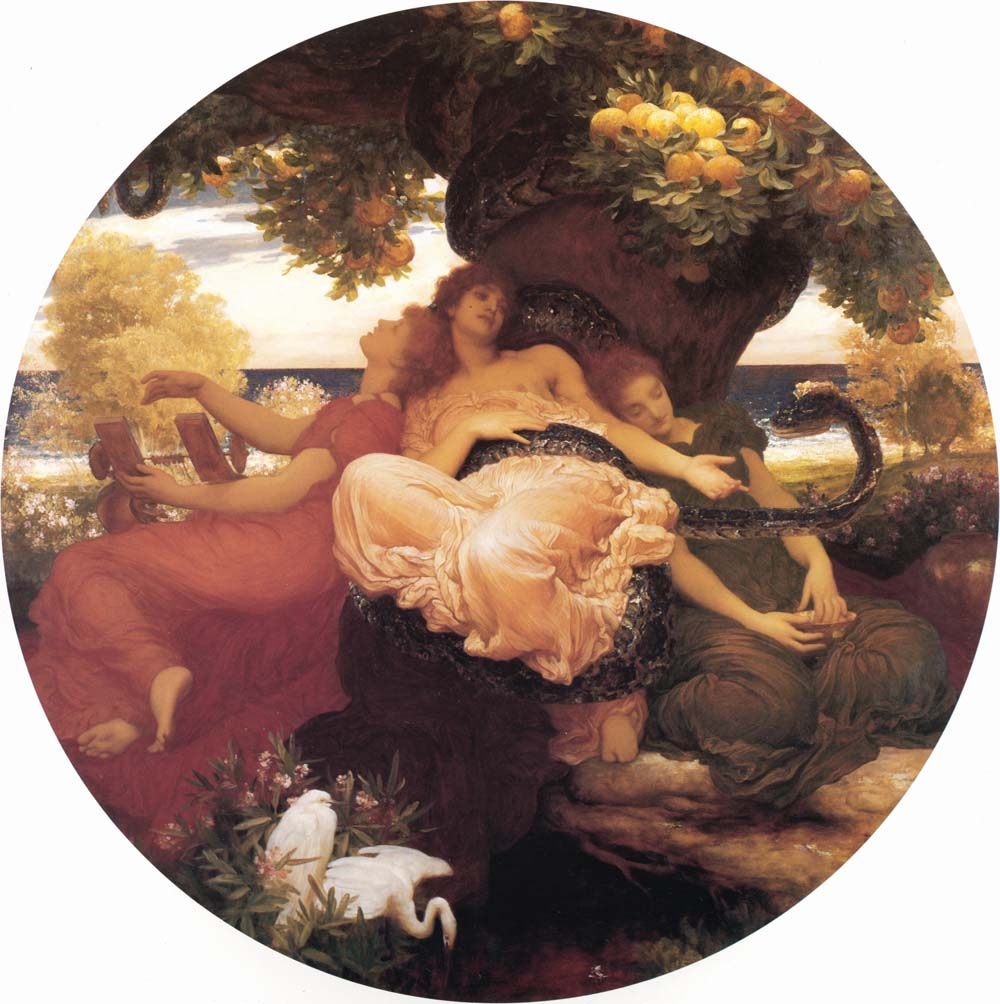
The Hesperides are the daughters of the titan Atlanta and the evening star Hesperus. They lived at the very end of the world in a huge garden, where magic apples ripened under the protection of a formidable dragon.
Scylla and Charybdis

These two monsters hid in the rocks on both sides of the streams between Italy and Sicily. Scylla had six huge heads, and each of them had three rows of sharp teeth in their mouths. Charybdis let out poisonous smoke to their mouths, and sea water boiled in her belly. These monsters hunted the ships passing by their possessions in order to kill and eat people.









